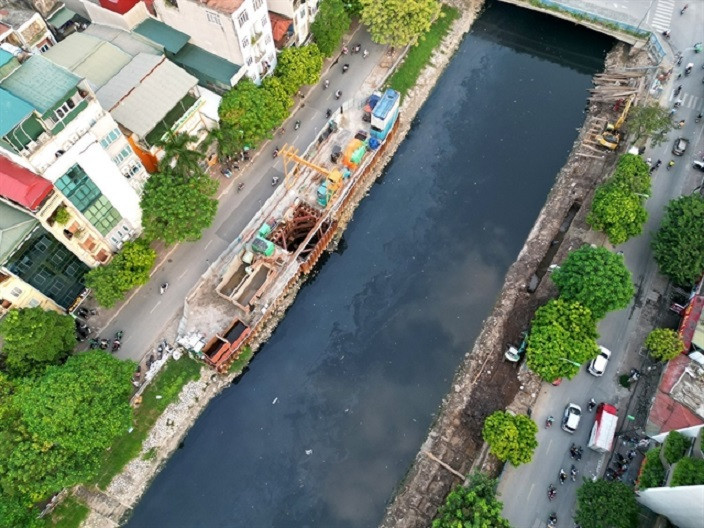
The main components of the Yên Xá wastewater treatment system construction project have been essentially completed and are scheduled to undergo trial operation in the second quarter of 2024, with full operation expected later this year, the project’s management board has said.
As a result, the urban wastewater treatment rate in Hà Nội is set to double from the current 28.8 per cent to approximately 50 per cent, contributing to the improvement of severely polluted rivers in the capital, especially the Tô Lịch River.
Trương Quốc Bảo, head of the Yên Xá Wastewater Treatment Infrastructure Investment Project Management Board, stated that this project is a focal point for the city.
With a total investment of over VNĐ16.293 trillion, the project began in 2019 and simultaneously implemented four bidding packages tasked with collecting and treating domestic wastewater currently being discharged directly into Hà Nội's main rivers such as the Tô Lịch, Lừ, Sét rivers, and partly from new urban areas in Hà Đông District.
To date, Package No 1, the main part of the project involving the construction of the Yên Xá Wastewater Treatment Plant by the Japanese contractor JFE-TSK Joint Venture Company, has reached approximately 97 per cent completion.
The construction unit for Package No 1 is currently finalising internal roads and monitoring stations and conducting equipment testing for trial operation set for the second quarter of 2024.
The remaining packages are tasked with constructing sewage systems to collect wastewater. Currently, Package No 2, which involves constructing sewers for the Tô Lịch River and the main sewer by the Japanese contractor TEKKEN Company, has reached 93 per cent completion. It is expected to finish ahead of schedule before March 2025.
Bảo said: “The completion of the project is set for 2025, but the two largest bidding packages have essentially been completed.
"Currently, we are compiling documents to submit to the Ministry of Natural Resources and Environment for discharge permits for trial operation, after which we will seek permission to operate the plant.
“It is anticipated that the plant will be fully operational this year."
Packages No 3 and 4 are currently resolving issues to continue construction.
Bảo emphasised that to achieve the operational goals of the two main bidding packages of the project, the investor and construction contractors are currently making efforts to complete the connecting infrastructure.
“We are striving in 2024 to collect all the wastewater currently flowing into the Tô Lịch River to be treated at the plant,” he said.
He added that the Yên Xá wastewater treatment project has a capacity of up to 270,000 cubic metres per day. The project management board has reported to the city that upon completing the trial operation, the plant will immediately operate at its full capacity to ensure collection and treatment of wastewater before discharge back into the river.
He also shared optimism that once the project is officially operational, 150 main domestic wastewater discharge points along the banks of the Tô Lịch River will be redirected to the plant for treatment instead of being discharged directly into the river.
“After treatment, the wastewater, meeting standards, will be discharged back into the Tô Lịch and Nhuệ rivers. This will make the rivers cleaner and more sustainable, as desired by the citizens of the capital,” he said.
The current rate of wastewater collection and treatment meeting urban area standards in Hà Nội is only 28.8 per cent, equivalent to 276,300 cubic metres per day. This rate will increase to 546,300 cubic metres per day, reaching approximately 50 per cent when the project is completed and put into operation.
Chong Jiun Yiat, CEO of the Yên Xá wastewater treatment project of Teken Corporation, mentioned that at times, some rivers in major cities in Japan faced similar situations to the Tô Lịch River. However, thanks to wastewater treatment system construction, these rivers have gradually become cleaner, and now fish can be seen swimming in them.
During a recent project progress inspection, Hà Nội Party Secretary Đinh Tiến Dũng said that collecting and treating wastewater will improve the environment for important rivers in the capital such as the Tô Lịch, Lừ, and Sét rivers, gradually making them cleaner and greener.
Therefore, he requested relevant units to closely adhere to requirements, push for task implementation, ensure effectiveness and quality, and decisively put the project into trial and official operation according to plan. — VNS